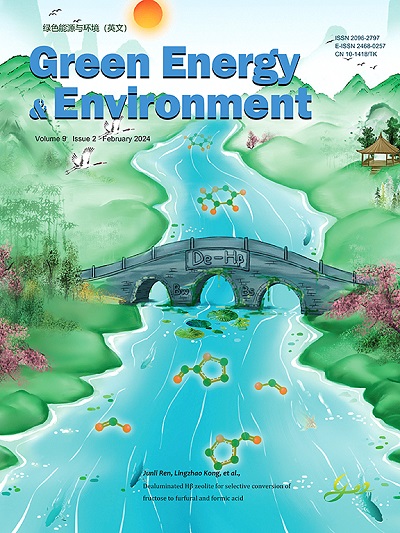CO2 mineralization by typical industrial solid wastes for preparing ultrafine CaCO3: A review
IF 10.7
1区 工程技术
Q1 CHEMISTRY, PHYSICAL
引用次数: 0
Abstract
Mineral carbonation is a promising CO sequestration strategy that can utilize industrial wastes to convert CO into high-value CaCO. This review summarizes the advancements in CO mineralization using typical industrial wastes to prepare ultrafine CaCO. This work surveys the mechanisms of CO mineralization using these wastes and its capacities to synthesize CaCO, evaluates the effects of carbonation pathways and operating parameters on the preparation of CaCO, analyzes the current industrial application status and economics of this technology. Due to the large amount of impurities in solid wastes, the purity of CaCO prepared by indirect methods is greater than that prepared by direct methods. Crystalline CaCO includes three polymorphs. The polymorph of CaCO synthesized by carbonation process is determined the combined effects of various factors. These parameters essentially impact the nucleation and growth of CaCO by altering the CO supersaturation in the reaction system and the surface energy of CaCO grains. Increasing the initial pH of the solution and the CO flow rate favors the formation of vaterite, but calcite is formed under excessively high pH. Vaterite formation is favored at lower temperatures and residence time. With increased temperature and prolonged residence time, it passes through aragonite metastable phase and eventually transforms into calcite. Moreover, polymorph modifiers can decrease the surface energy of CaCO grains, facilitating the synthesis of vaterite. However, the large-scale application of this technology still faces many problems, including high costs, high energy consumption, low calcium leaching rate, low carbonation efficiency, and low product yield. Therefore, it is necessary to investigate ways to accelerate carbonation, optimize operating parameters, develop cost-effective agents, and understand the kinetics of CaCO nucleation and crystallization to obtain products with specific crystal forms. Furthermore, more studies on life cycle assessment (LCA) should be conducted to fully confirm the feasibility of the developed technologies.典型工业固体废物的二氧化碳矿化,用于制备超细 CaCO3:综述
矿物碳化是一种很有前景的一氧化碳封存策略,可利用工业废料将一氧化碳转化为高价值的 CaCO。本综述总结了利用典型工业废物制备超细 CaCO 的一氧化碳矿化进展。这项工作调查了利用这些废物进行 CO 矿化的机制及其合成 CaCO 的能力,评估了碳化途径和操作参数对制备 CaCO 的影响,分析了该技术的工业应用现状和经济性。由于固体废弃物中含有大量杂质,间接法制备的 CaCO 纯度高于直接法制备的 CaCO 纯度。结晶 CaCO 包括三种多晶体。通过碳化工艺合成的 CaCO 的多晶型取决于各种因素的综合影响。这些参数主要通过改变反应体系中的 CO 过饱和度和 CaCO 晶粒的表面能来影响 CaCO 的成核和生长。提高溶液的初始 pH 值和 CO 流速有利于钒酸盐的形成,但在 pH 值过高的情况下会形成方解石。在温度和停留时间较低的情况下,更有利于aterite 的形成。随着温度的升高和停留时间的延长,它将穿过文石稳定相,最终转变为方解石。此外,多晶体改性剂可降低 CaCO 晶粒的表面能,促进aterite 的合成。然而,该技术的大规模应用仍面临许多问题,包括成本高、能耗高、钙浸出率低、碳化效率低、产品产量低等。因此,有必要研究加速碳化的方法、优化操作参数、开发具有成本效益的制剂,并了解 CaCO 成核和结晶的动力学,以获得具有特定晶体形态的产品。此外,还应开展更多的生命周期评估(LCA)研究,以充分证实所开发技术的可行性。
本文章由计算机程序翻译,如有差异,请以英文原文为准。
求助全文
约1分钟内获得全文
求助全文
来源期刊

Green Energy & Environment
Energy-Renewable Energy, Sustainability and the Environment
CiteScore
16.80
自引率
3.80%
发文量
332
审稿时长
12 days
期刊介绍:
Green Energy & Environment (GEE) is an internationally recognized journal that undergoes a rigorous peer-review process. It focuses on interdisciplinary research related to green energy and the environment, covering a wide range of topics including biofuel and bioenergy, energy storage and networks, catalysis for sustainable processes, and materials for energy and the environment. GEE has a broad scope and encourages the submission of original and innovative research in both fundamental and engineering fields. Additionally, GEE serves as a platform for discussions, summaries, reviews, and previews of the impact of green energy on the eco-environment.
 求助内容:
求助内容: 应助结果提醒方式:
应助结果提醒方式:


